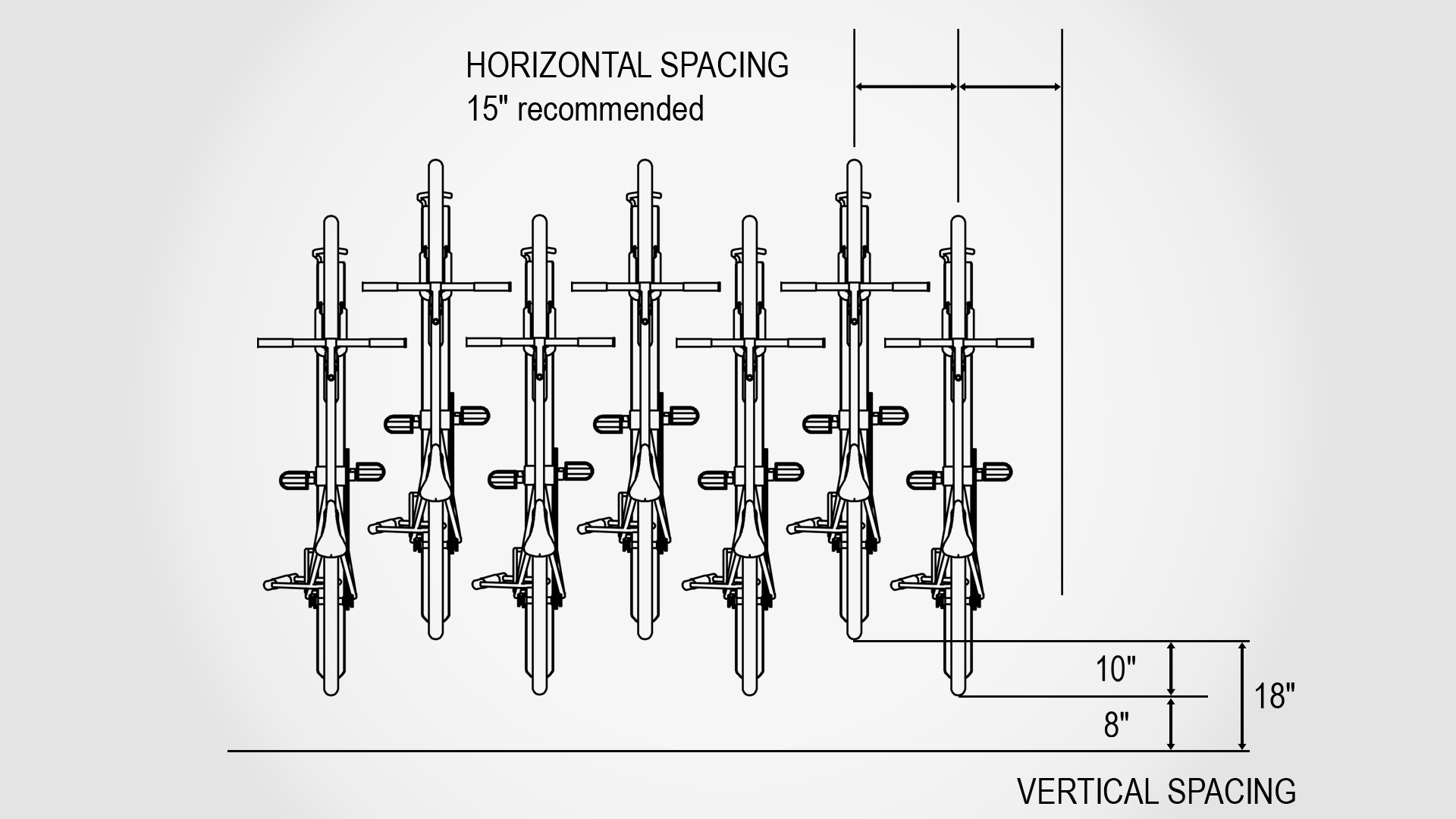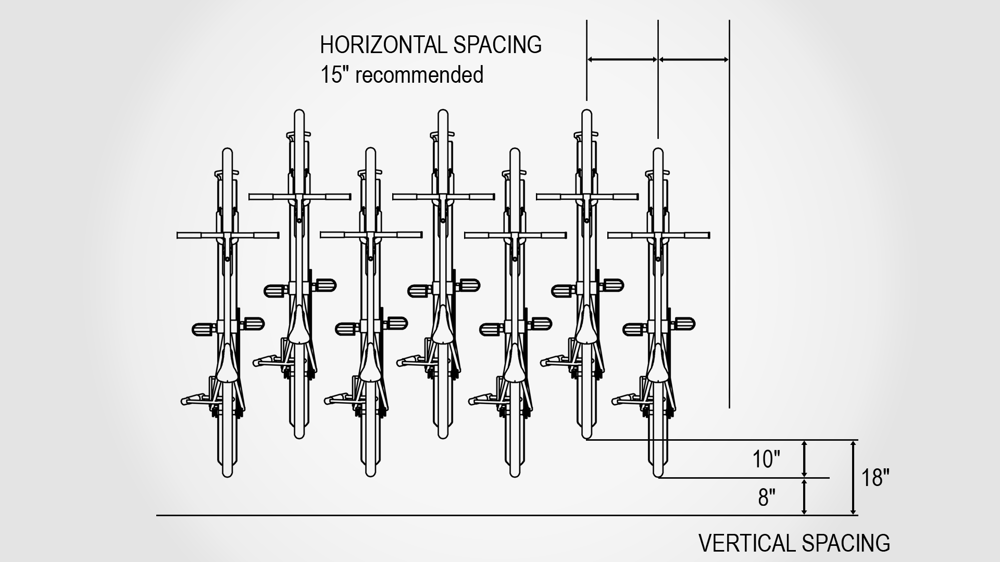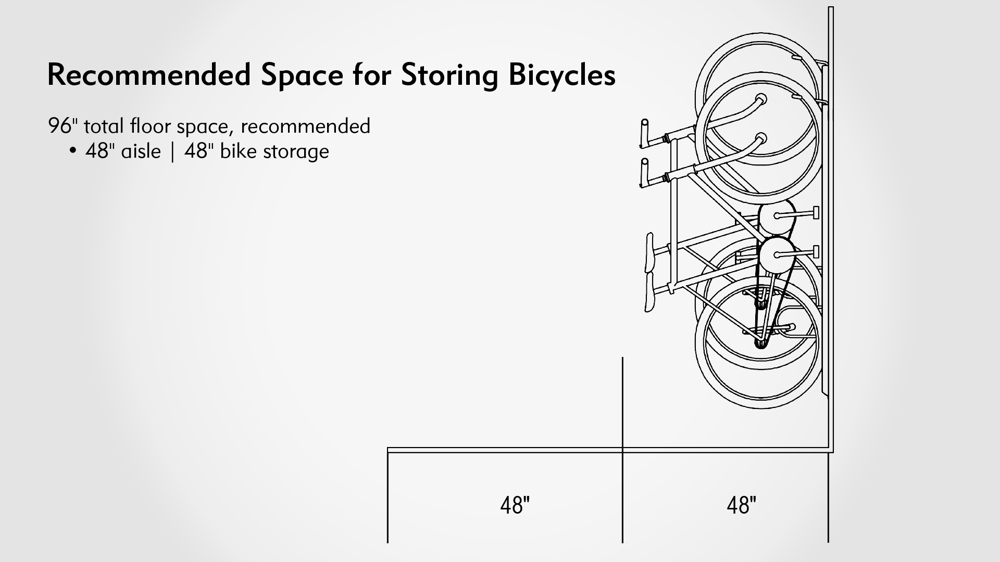Bike Storage Space - The Correct Way

One of the most important aspects in setting up a bike storage is ensuring that bike racks are spaced out correctly.
First, you need to make sure make sure there is enough space between each rack.
Second, you need to ensure that you can both store a bicycle in a space and leave enough clearance to create an aisle. Otherwise the bike rack could become unusable.
If you want to have bike rack parameters and spacing visualized for you, check out our Bike Room Builder!
Let's go over bike storage space recommendations in more detail for the different types of bike storage racks.
Spacing for Ground Bike Racks
When preparing to fasten bike racks to the ground, begin by setting the racks a recommended 36" off of the wall, or minimally, 24". This provides enough space for a bike to properly be centered and rest against the rack.
There should also be 48", or 36" minimum, of clearance on either side of the bike rack. This is enough room for bicycles to maneuver into the bike parking spot, while also allowing a user to lock/unlock their bicycle from the side.
There should also be 60", or 48" minimum, of aisle space beyond the tire of a parked bicycle. This would be measured to the tire of another bicycle or a wall, depending on your layout.

Spacing Recommendations
- Space for the bicycle: 72" for a standard bicycle
- Distance between racks: 48" recommended | 36" minimum
- Setbacks from walls/obstruction
- Oriented perpendicular to wall
- 36" minimum to nearest post
- 48" minimum to center of rack
- Oriented parallel to wall
- 36" recommended | 24" minimum
- Oriented perpendicular to wall
- Aisles: 60" recommended | 48" minimum
One option that can make spacing bike racks easier is getting bike racks on rails. Racks on rails have pre-placed spacing and parking spaces do not need to be measured out.
In high-density applications, this could be a cost-saving measure because it would eliminate labor hours needed to measure spaces between bike racks.
Then, all you would need to know are the spacing requirements away from walls and distances for aisles. This can usually be found in installation instructions provided by the manufacturer.
Vertical Bike Rack Spacing
Vertical bike racks should provide bikes with at least 8” of clearance from the ground.
The center of a rack should also be placed at least 15" away from a perpendicular wall. This provides enough clearance for standard size handlebars to fit next to the wall.
Place racks 15" apart from each other, horizontally, and stagger them up to 10".

It's important that the height of each rack be staggered. If vertical bike racks are all mounted at the same height, they will need to be spaced at least 24" apart. This is done to prevent handlebars from making the racks unusable.
For strut-mounted bike racks, follow the manufacturer's instructions. This will direct you as to the height the channels will need to be mounted to the walls.
Once the racks are adhered to the channels, they will hold a bicycle at the correct height.
With freestanding bike racks, simply assemble per the manufacturer's installation directions and the racks will be set at the designed height.
Aisle Space
After you have properly spaced your vertical bike racks, you will need to account for an aisle behind the stored bicycle.
A standard, full-sized bicycle from tire to seat is roughly 48". You will then need an additional 48" to create aisle space beyond this, which should remain completely clear.

This aisle offers enough room to raise/lower bicycles onto the rack and maneuver them in and out of the bike storage area.
In total, 96" of clearance are needed from off the wall to use a vertical bike rack effectively.
Vertical Bike Rack Dimensions
- Space for bicycle: 96" total floor space, recommended (48" bike storage space | 48" aisle space)
- Horizontal Spacing Between Staggered rack: 16" Recommended | 14" minimum
- Vertical Spacing Between Staggered Racks: Typically, between 8"-12"
- Vertical Clearance - Varies depending on rack used. Can be determined by finding the sum of three dimensions
- Ground clearance (Typically 8" minimum)
- Bicycle length (72" minimum)
- Lifting clearance (Depth of hook that supports bicycle)
Spacing for Two-tier Bike Racks
Two-tier bike racks typically come as complete units, so you won't have to worry about horizontal or vertical spacing.
The sides of the unit will need to be placed with 10" to 15" of clearance to provide space for the handlebars of stored bicycles.
You will then need to factor for aisle space beyond the rack. This again, should be at least 48".
You will also, generally, need 9' of clearance measured from the ground to the ceiling or other overhead obstruction, like a ceiling fan or lights, to store bicycles with these racks.

Spacing for Bike Lockers
By design, bike lockers are relatively modular and are meant to be banked next to one another.
The one spacing item to be aware of is the aisle between two facing lockers or a locker door and a wall. This is measured based on when the door is completely open.
Depending on the size of bike locker, the door can range from about 30" to 40" in size. Along with a 48" aisle, you would need a distance of 78" to 88" between the locker unit and a wall or open door of another locker.

When placing bike racks, keep the in mind that these measurements are recommendations meant to provide general guidance for your layout.
They could change depending on the specific bike rack you use or your building codes. Make sure to use the manufacturer's installation instructions and make sure you understand the bike storage requirements based on local ordinances for specific spacing information.
Related Resources
- [Download] Bike Storage Guide
- [Article] Vertical Bike Parking Systems
- [Video] High Density Bike Storage


